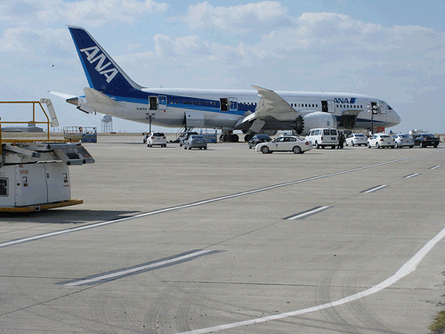Boeing again finds itself face-to-face with the prospect of delays to its 787 Dreamliner following an in-flight electrical fire that grounded its test fleet.
The 9 November fire occurred aboard the second of six 787 flight-test aircraft, ZA002, in the minutes before the 14:54 local time touchdown at Laredo International Airport in Texas. All 42 test personnel on board were evacuated safely via the emergency escape slide system; there was one very minor injury.
The fire destroyed the P100 power control panel on the left side of the aft electrical equipment bay. The P100 distributes the left engine's electrical power to the 235V AC bus before being converted for various applications on board. The five remaining 787s have been moved to ground testing while the investigation is under way.
Boeing says it will not rush its technical team that is conducting a round-the-clock investigation that will take "several days". The company added: "We cannot determine the impact of this event on the overall programme schedule until we have worked our way through the data."
 |
|---|
© Stevie Eliz |
During the flight, smoke and flames were seen coming from the 787's aft electrical equipment bay, which sits below the cabin floor, forward to the aft cargo compartment in Section 46. The fire knocked out the aircraft's primary electrical power and caused the ram air turbine to deploy.
Laredo Fire Department representatives confirm the fire was not extinguished until after touchdown, but adds that the fire had been contained before the arrival of firefighters, who found heavy smoke on board.
ZA002 was nearing the completion of a long-range test from Yuma, Arizona of the aircraft nitrogen generation system (NGS) meant to inert fuel vapour preventing ignition.
The concern, say industry analysts, centres not only on the cause of the fire, but the rapid cascading of failures that unfolded in the minutes before touchdown in Laredo, including the loss of primary electrical power, some of the flight deck displays and auto throttle control, as well as the deployment of the ram air turbine. Boeing emphasises that the "pilots executed a safe landing and at all times had positive control of the airplane, and all of the information necessary to perform that safe landing".
The area surrounding the power control panel is believed to have suffered extensive damage, say those familiar with the incident.
Boeing's 787 contained three major leaps in innovation: the global manufacturing scheme; majority composite primary structure; and its more-electric systems architecture.
After delays cause by a weakness in the composite and titanium side-of-body join and the faltering of its global supply chain, the 787's systems had escaped the spotlight. However, the electrical fire has raised the prospect of additional programme delays.
Boeing's first delivery to launch customer All Nippon Airways, whose colours adorn ZA002, is slated for mid-February 2011 - nearly three years late.
Source: Flight International























